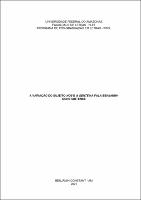| ???jsp.display-item.social.title??? |


|
Please use this identifier to cite or link to this item:
https://tede.ufam.edu.br/handle/tede/8317| ???metadata.dc.type???: | Dissertação |
| Title: | A variação do sujeito "nós" e "a gente" na fala Benjamin-constantense. |
| ???metadata.dc.creator???: | Fernandes, Helbia Reis  |
| ???metadata.dc.contributor.advisor1???: | Azevedo, Orlando da Silva |
| ???metadata.dc.contributor.referee1???: | Oliveira, Mateus Coimbra de |
| ???metadata.dc.contributor.referee2???: | Silva, Raynice Geraldine Pereira da |
| ???metadata.dc.description.resumo???: | Esta pesquisa foi embasada nos pressupostos teórico-metodológicos da Teoria da Variação e Mudança (LABOV, 1972), e teve como objetivo geral analisar, na posição de sujeito, o uso da variável /nós/ em suas realizações pronominais como nós e a gente na fala de moradores da cidade de Benjamin Constant/AM, que está localizada no Alto Solimões, região de tríplice fronteira (Brasil, Peru e Colômbia). Além do objetivo geral, foram traçados os seguintes objetivos específicos: i) identificar os fatores linguísticos e extralinguísticos que interferem na ocorrência das variantes nós e a gente; ii) explicar se existe relação entre o grau de escolaridade, o contexto social, o sexo, a idade e a variável em estudo: P4 /nós/, primeira pessoa do plural, e suas variantes nós e a gente. Nesta pesquisa, a amostra foi constituída por onze entrevistas, cujos informantes foram distribuídos por três faixas etárias (de 18 a 30 anos; de 31 a 50 anos; e de 51 a 65 anos); por sexo (masculino e feminino); e por escolaridade (Ensino Fundamental 1, Ensino Fundamental 2 e Ensino Médio Completo). Apesar das limitações da pesquisa resultantes de contexto pandêmico vivenciado em 2020 e ainda em 2021, conseguimos finalizá-la. Considerando a análise estatística, incluindo todas as variáveis tanto intralinguísticas quanto extralinguísticas, o programa GoldVarb X selecionou como relevantes o fator de ordem linguística Paralelismo Formal e os fatores de ordem extralinguística sexo, escolaridade e faixa etária. Os resultados mostraram que as realizações pronominais da variável /nós/ foram mais expressivas segundo os fatores: intralinguístico, no Paralelismo Formal, em que a incidência maior foi para a variante a gente; e extralinguísticos: por sexo, sendo mais incidente a variante a gente, na fala das mulheres; e por escolaridade, ocorrendo de forma mais incidente segundo o parâmetro ensino fundamental 2 e nível médio, a variante a gente; porém, segundo o fator Ensino Fundamental 1, as duas variantes foram empregadas na mesma proporção; e por faixa etária, a variante a gente foi mais empregada no fator faixa etária 2 e 3, enquanto o fator faixa etária 1 favoreceu o emprego da variante nós. Palavras-Chave: Sociolinguística; Variação nós e a gente; Benjamin Constant. |
| Abstract: | This research was based on the theoretical-methodological assumptions of the Theory of Variation and Change (LABOV, 1972), and it had as a general objective to analyze, in the position of subject, the use of the variable /us/ in its pronominal realizations as nós and a gente in the dialect of residents of the city of Benjamin Constant/AM, which is located in Alto Solimões, in triple border region (Brazil, Peru and Colombia). In addition to the general objective, the following specific objectives were outlined: i) to identify the linguistic and extralinguistic factors that interfere in the occurrence of the nós and a gente variants; ii) explain whether there is a relationship between the level of education, social context, gender, age and the variable under study: P4 /nós/, first person plural, and its variants nós and a gente. In this research, the sample consisted of eleven interviews, whose informants were distributed over three age groups (from 18 to 30 years old; from 31 to 50 years old; and from 51 to 65 years old); by sex (male and female); and by schooling (Elementary School 1, Elementary School 2 and Complete High School). Despite the limitations of the research resulting from the pandemic context experienced in 2020 and still in 2021, we could to finished it. Considering the statistical analysis, including all intralinguistic and extralinguistic variables, the GoldVarb X program selected as relevant the linguistic factor Formal Parallelism and the extralinguistic factors sex, education and age group. The results showed that the pronominal realizations of the variable /we/ were more expressive according to the factors: intralinguistic, in Formal Parallelism, in which the highest incidence was for the variant a gente; and extralinguistic: by sex, it was more incident the variant a gente, in the speech of women; and by schooling, occurring more incidentally according to the parameter elementary education 2 and high school, the variant a gente; however, according to the Elementary Education factor 1, the two variants were used in the same proportion; and by age group, the variant a gente was more used in the age group factor 2 and 3, while the age group factor 1 favored the use of the variant nós. Key words: Sociolinguistics; nós and a gente Variation; Benjamin Constant. |
| Keywords: | Teoria da Variação e Mudança Variação linguística Fatores linguísticos Paralelismo formal Benjamin Constant (AM) |
| ???metadata.dc.subject.cnpq???: | LINGUÍSTICA, LETRAS E ARTES |
| ???metadata.dc.subject.user???: | Variação Nós e A gente Sociolinguística Português Brasileiro |
| Language: | por |
| ???metadata.dc.publisher.country???: | Brasil |
| Publisher: | Universidade Federal do Amazonas |
| ???metadata.dc.publisher.initials???: | UFAM |
| ???metadata.dc.publisher.department???: | Faculdade de Letras |
| ???metadata.dc.publisher.program???: | Programa de Pós-graduação em Letras |
| Citation: | FERNANDES, Helbia Reis. A variação do sujeito "nós" e "a gente" na fala Benjamin-constantense. 2021. 134 f. Dissertação (Mestrado em Letras) - Universidade Federal do Amazonas, Manaus, 2021. |
| ???metadata.dc.rights???: | Acesso Aberto |
| URI: | https://tede.ufam.edu.br/handle/tede/8317 |
| Issue Date: | 14-Apr-2021 |
| Appears in Collections: | Mestrado em Letras |
Files in This Item:
| File | Description | Size | Format | |
|---|---|---|---|---|
| Dissertação_HelbiaFernandes_PPGL.pdf | Dissertação_HelbiaFernandes_PPGL | 8.38 MB | Adobe PDF |  Download/Open Preview |
Items in DSpace are protected by copyright, with all rights reserved, unless otherwise indicated.




